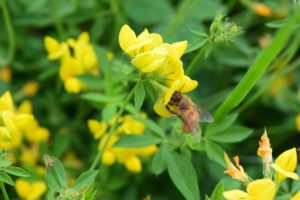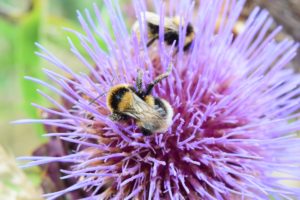Beekeeping at Kotare Village
Written by Renee
Bees have been around for at least 40 million years; with some estimates of fossilized honeybees that could potentially date back 150 million years! Bees are the best-known insect on the planet and are the planets most important pollinator of food crops, thus they are central to our survival and deserve to be treated with care, respect and dignity. Careful facilitation of bees at Kotare Village is an important consideration and through the design of our vegetable and forest gardens we are committed to include plenty of high quality, nutrient-dense forage for the bees to remain strong and healthy; that way, the bees have a better chance of co-evolving within our environment and to maintain their integrity and strength. We follow a natural beekeeping approach, which minimizes human interventions and does not include queen replacement, instead allowing the bees to swarm as part of their natural survival mechanism to achieve this aim for themselves. Another part of this low impact approach is to use Warre hives in which the bees can draw out their own combs and don’t have to fit into an artificial plastic frame.
My initial interest for natural beekeeping started in the fall of 2016 when I attended a workshop at the Koanga Institute. It took me a little while to actually decide to get involved in beekeeping but this spring, I teamed up with Jenny who is also a novice along with Kay, an experienced beekeeper in the village who guides us as a mentor. Presently, the three of us make the official beekeeping group at Kotare.
We did not start from scratch because Kay and Bob already had a few functioning hives, but to provide honey for the village, we needed more hives. Early this season, I made a flyer to advertise “our swarm collection services” and distributed it in mailboxes and on notice boards in the wider region.
Being a novice, I had to come up to speed with my swarm catching skills. Online video clips are great to learn everything about anything including swarm removal but there is nothing like real life experience. In the clips, things ran smoothly of course, but our first swarm collection was not so easy. A swarm 5-6 meters up in a tree tucked between branches is what we found on the farmer’s site. This is another story…
Currently there are four hives in the village, Kay checks to make sure the bees are happy and we learn from her. Being a DECA holder she can officially inspect the hives, knows how to read the bees and identify problems quickly. I look forward to gaining some of those skills and in the meantime, I have registered to a DECA course in March. From this, I will be able to inspect the hives and sign the annual form for disease inspection. It will take some years to gain an in depth understanding of bee behavior and respond appropriately.
It is a pleasure to be around bees. They are gentle, beautiful, complex and, at times, quite funny to look at. It is fascinating to watch them bring the colorful pollen to the hive. From bright yellow, to white, orange, and even purple, they travel long distances with their legs filled with pollen. They work tirelessly from dawn to dusk and are hardwired to care for their survival.
I look forward to continue working with this wondrous and inspiring super-organism and immerse myself more into the bees’ graceful nature.



No comments yet.